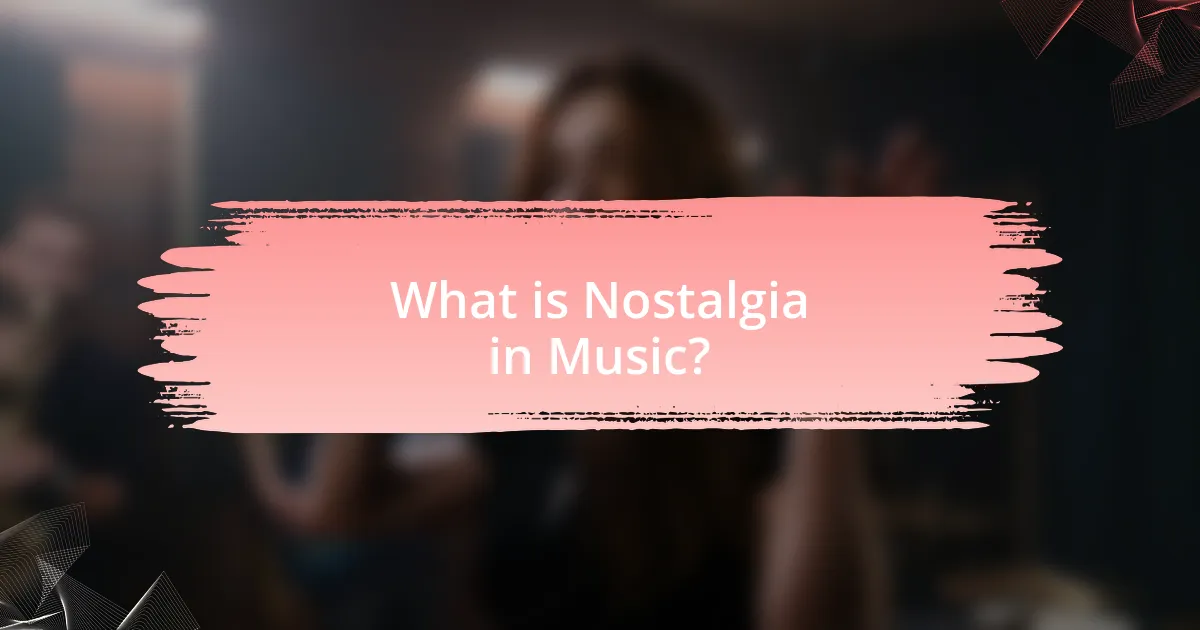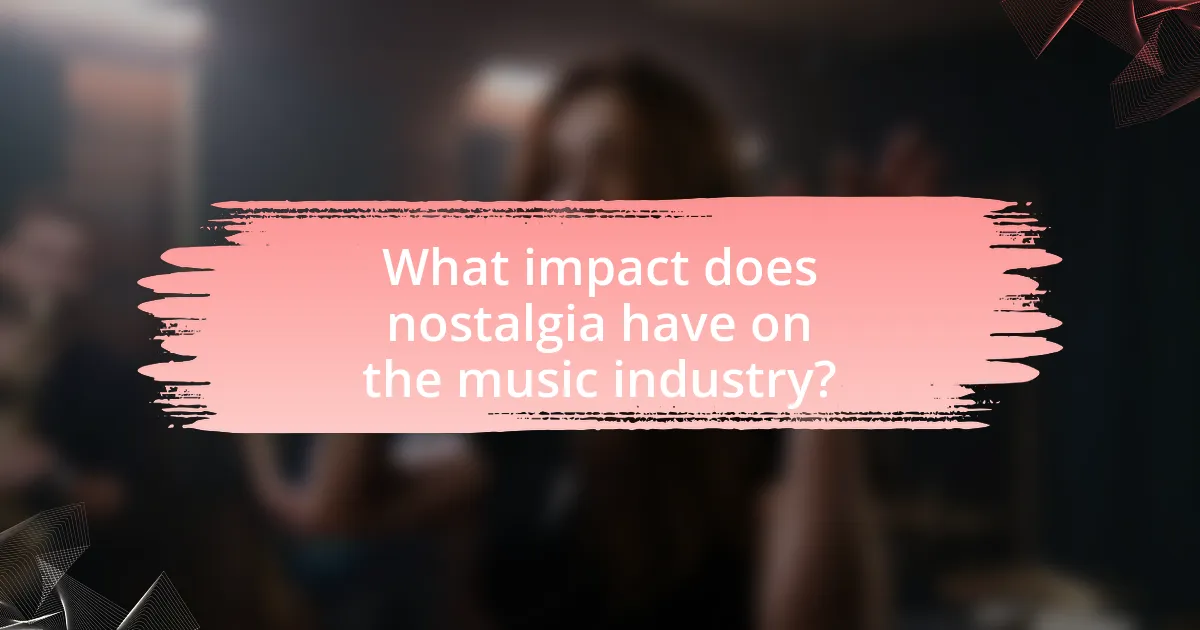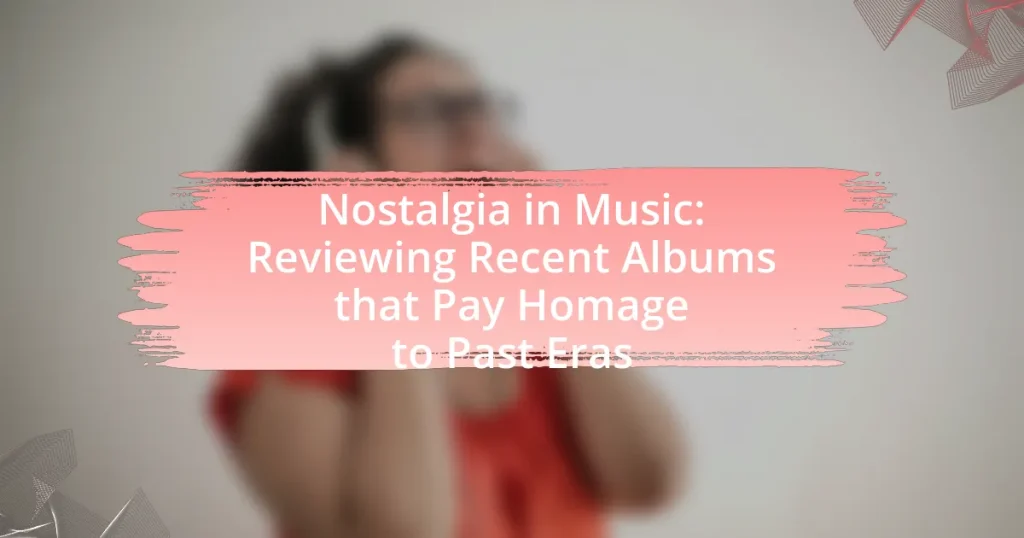Nostalgia in music refers to the emotional longing for the past, often expressed through melodies, lyrics, and production styles that evoke earlier times. This article explores how nostalgia influences musical creativity, enhances emotional well-being, and shapes listener experiences. It examines the incorporation of nostalgic elements in contemporary albums, highlighting notable works such as Adele’s “30,” Taylor Swift’s “Fearless (Taylor’s Version),” and Silk Sonic’s “An Evening with Silk Sonic.” Additionally, the article discusses the psychological effects of nostalgia on listeners, the impact on the music industry, and the potential downsides of an over-reliance on nostalgic themes in music.

What is Nostalgia in Music?
Nostalgia in music refers to the emotional longing for the past, often evoked through melodies, lyrics, and production styles that remind listeners of earlier times. This phenomenon can be observed in contemporary songs that incorporate vintage sounds or themes, creating a sense of familiarity and comfort. Research indicates that nostalgia can enhance emotional well-being, as evidenced by a study published in the journal “Emotion,” which found that nostalgic music can evoke positive memories and feelings, reinforcing its significance in the music industry.
How does nostalgia influence musical creativity?
Nostalgia significantly influences musical creativity by inspiring artists to draw upon past experiences, styles, and cultural references in their work. This emotional connection to earlier times can lead to the revival of vintage sounds, instrumentation, and lyrical themes that resonate with both the creator and the audience. Research indicates that nostalgia can enhance creativity by fostering a sense of belonging and continuity, which encourages musicians to explore and reinterpret historical musical elements. For instance, a study published in the journal “Psychology of Music” by Wildschut et al. (2006) found that nostalgic feelings can enhance creative problem-solving and idea generation, suggesting that artists may tap into nostalgic sentiments to innovate within their music.
What psychological effects does nostalgia have on listeners?
Nostalgia has several psychological effects on listeners, primarily evoking feelings of warmth, happiness, and a sense of belonging. Research indicates that nostalgia can enhance mood and increase feelings of social connectedness, as it often involves recalling positive memories associated with past experiences. A study by Wildschut et al. (2006) published in the journal Emotion found that nostalgia can counteract feelings of loneliness and anxiety, providing comfort and a sense of continuity in life. Additionally, nostalgia can stimulate creativity and inspire individuals, as it often leads to a reflective state that encourages personal growth and exploration.
How do artists incorporate nostalgic elements into their music?
Artists incorporate nostalgic elements into their music by utilizing specific sounds, lyrical themes, and production techniques that evoke memories of past musical eras. For instance, many contemporary musicians sample classic tracks or use vintage instruments, such as synthesizers from the 1980s, to create a familiar auditory experience. Additionally, lyrical content often references cultural touchstones from previous decades, such as iconic events or popular trends, which resonate with listeners’ memories. Research indicates that nostalgia can enhance emotional engagement, making songs more relatable and memorable, as seen in the resurgence of genres like synth-pop and retro rock in recent albums.
Why is nostalgia a recurring theme in music?
Nostalgia is a recurring theme in music because it evokes emotional connections to past experiences, allowing listeners to relive cherished memories. This emotional resonance is supported by psychological studies indicating that nostalgia can enhance mood and foster a sense of belonging. For instance, research published in the journal “Emotion” by Wildschut et al. (2006) demonstrates that nostalgic music can trigger memories that provide comfort and a sense of continuity in life. Additionally, artists often draw on nostalgic elements to create a familiar sound that resonates with audiences, tapping into collective memories associated with specific eras or cultural moments.
What historical events have shaped nostalgic music trends?
Historical events such as the Vietnam War, the rise of punk rock in the 1970s, and the cultural shifts of the 1980s have significantly shaped nostalgic music trends. The Vietnam War, which spanned from 1955 to 1975, influenced a generation of musicians who reflected the turmoil and disillusionment of the era in their music, leading to a resurgence of folk and protest songs. The emergence of punk rock in the 1970s, characterized by its raw sound and anti-establishment themes, created a nostalgic longing for rebellion and authenticity in later music trends. Additionally, the cultural shifts of the 1980s, including the advent of MTV and the popularity of synth-pop, have led to a revival of 80s aesthetics and sounds in contemporary music, as artists seek to evoke the feelings associated with that vibrant decade. These events collectively contribute to the ongoing cycle of nostalgia in music, as artists draw inspiration from past eras to connect with audiences emotionally.
How do different genres express nostalgia uniquely?
Different genres express nostalgia uniquely through their distinct musical styles, lyrical themes, and cultural references. For instance, rock music often evokes nostalgia by incorporating classic instrumentation and referencing past cultural icons, as seen in albums that utilize vintage guitar sounds reminiscent of the 1970s. In contrast, hip-hop may express nostalgia through sampling older tracks, creating a bridge between past and present, as demonstrated by artists who incorporate beats from the 90s into their contemporary work. Similarly, country music frequently draws on storytelling that reflects traditional values and rural life, tapping into a sense of longing for simpler times. Each genre utilizes its unique characteristics to evoke specific memories and emotions associated with the past, thereby creating a distinct nostalgic experience for listeners.

Which recent albums exemplify nostalgia in music?
Recent albums that exemplify nostalgia in music include “30” by Adele, “Fearless (Taylor’s Version)” by Taylor Swift, and “An Evening with Silk Sonic” by Silk Sonic. Adele’s “30” reflects on past relationships and emotions, drawing from her earlier work while incorporating vintage sounds. Taylor Swift’s re-recording of “Fearless” evokes early 2000s country-pop, appealing to fans’ memories of her debut era. Silk Sonic’s album channels 1970s funk and soul, creating a retro vibe that resonates with listeners seeking a nostalgic experience. These albums effectively capture and celebrate past musical influences, making them significant examples of nostalgia in contemporary music.
What are some notable albums that pay homage to past eras?
Notable albums that pay homage to past eras include “25” by Adele, which reflects the soulful sounds of the 1960s and 70s, and “American Utopia” by David Byrne, which incorporates elements of funk and world music reminiscent of earlier decades. Additionally, “Golden Hour” by Kacey Musgraves draws inspiration from classic country and pop influences, while “The 1975” by The 1975 features 80s synth-pop sounds. These albums not only evoke nostalgia but also showcase the artists’ ability to blend contemporary styles with historical musical elements, reinforcing their connection to the past.
How do these albums reflect the sounds of their respective eras?
These albums reflect the sounds of their respective eras by incorporating musical styles, production techniques, and lyrical themes that were prevalent during those times. For instance, an album that emulates the 1980s sound often features synthesizers, drum machines, and a pop-oriented structure, mirroring the era’s iconic artists like Madonna and Prince. Additionally, lyrical content may address social issues or personal experiences relevant to that decade, enhancing the nostalgic connection. The use of vintage recording techniques or instrumentation, such as analog equipment, further solidifies the authenticity of the sound, allowing listeners to experience a sonic representation of the past.
What themes of nostalgia are prevalent in these albums?
Themes of nostalgia prevalent in these albums include reflections on past relationships, cultural references to earlier musical styles, and a longing for simpler times. These themes manifest through lyrical content that evokes memories of youth and significant life events, often utilizing vintage sounds and production techniques reminiscent of specific decades. For example, artists may incorporate elements from the 1980s synth-pop or 1990s grunge, creating a sonic landscape that transports listeners back to those eras. This connection to the past is further reinforced by the use of familiar motifs and storytelling that resonate with shared experiences, making the nostalgia feel authentic and relatable.
How have artists approached nostalgia in their recent works?
Artists have approached nostalgia in their recent works by integrating elements from past musical styles and cultural references to evoke emotional connections with listeners. For instance, many contemporary albums feature retro production techniques, such as analog recording methods and vintage instrumentation, which harken back to specific eras, like the 1980s synth-pop or 1990s grunge. This trend is evident in albums like Dua Lipa’s “Future Nostalgia,” which combines modern pop with disco influences, and The Weeknd’s “After Hours,” which draws heavily from 1980s R&B and synthwave. These artists utilize nostalgia not only to celebrate past sounds but also to create a sense of familiarity and comfort in their music, appealing to both older audiences and younger listeners who seek authenticity in their musical experiences.
What techniques do artists use to evoke nostalgia in their music?
Artists use techniques such as retro instrumentation, lyrical references, and familiar song structures to evoke nostalgia in their music. Retro instrumentation involves using vintage instruments or production techniques that harken back to specific eras, creating an auditory connection to the past. Lyrical references often include themes, phrases, or cultural touchstones that resonate with listeners’ memories, enhancing the emotional impact. Familiar song structures, such as the use of classic chord progressions or melodies reminiscent of earlier music styles, further reinforce this nostalgic feeling. These methods are effective because they tap into collective memories and cultural associations, making the music relatable and emotionally resonant for audiences.
How do collaborations with older artists enhance nostalgic elements?
Collaborations with older artists enhance nostalgic elements by integrating their distinctive styles and historical context into contemporary music. This fusion evokes memories of past musical eras, allowing listeners to connect emotionally with both the new and the familiar. For instance, when modern artists collaborate with legendary figures, they often incorporate signature sounds or lyrical themes that defined earlier genres, creating a bridge between generations. This technique not only honors the legacy of older artists but also reinforces the cultural significance of their contributions, as seen in projects like the collaboration between Jay-Z and David Bowie, which brought together hip-hop and rock influences, resonating with fans of both genres.

What impact does nostalgia have on the music industry?
Nostalgia significantly influences the music industry by driving consumer interest and shaping marketing strategies. This emotional connection to the past encourages artists to create music that evokes memories of previous decades, leading to a resurgence of retro styles and sounds. For instance, the popularity of synth-pop and 80s-inspired music in recent years illustrates how nostalgia can lead to commercial success, as seen with artists like Dua Lipa and The Weeknd, who incorporate vintage elements into their work. Additionally, nostalgia-driven albums often see increased sales and streaming numbers, as listeners seek to relive cherished moments associated with specific eras, thereby validating the impact of nostalgia on music consumption patterns.
How does nostalgia influence music marketing and sales?
Nostalgia significantly influences music marketing and sales by tapping into consumers’ emotional connections to past experiences and cultural moments. This emotional resonance drives purchasing decisions, as seen in the resurgence of vinyl records and retro-themed merchandise, which have seen a 20% increase in sales over the past five years according to the Recording Industry Association of America. Additionally, marketing campaigns that evoke nostalgia, such as those featuring classic hits or vintage aesthetics, often lead to higher engagement rates and brand loyalty, as consumers are drawn to familiar sounds and imagery that remind them of their formative years.
What role does nostalgia play in audience engagement?
Nostalgia significantly enhances audience engagement by evoking emotional connections to past experiences and memories. This emotional resonance can lead to increased enjoyment and a sense of belonging among listeners, as they relate to familiar sounds and themes reminiscent of earlier musical eras. Research indicates that nostalgia can trigger positive emotions, which in turn can enhance the likelihood of sharing and discussing music, thereby amplifying audience interaction. For instance, a study published in the journal “Psychology of Music” found that nostalgic music can foster social bonding and increase listeners’ willingness to engage with content related to their cherished memories.
How do streaming platforms capitalize on nostalgic trends?
Streaming platforms capitalize on nostalgic trends by curating playlists and producing content that evokes memories of past eras. For instance, platforms like Spotify and Apple Music create themed playlists featuring music from specific decades, such as the 1980s or 1990s, which attract listeners seeking to relive their formative years. Additionally, streaming services invest in original programming, such as documentaries and series that explore the cultural impact of iconic music from the past, further engaging audiences. This strategy is supported by data indicating that nostalgia-driven content often leads to increased user engagement and subscription retention, as seen in the success of shows like “The Get Down” on Netflix, which celebrates the origins of hip-hop culture.
What are the potential downsides of nostalgia in music?
The potential downsides of nostalgia in music include the risk of stifling innovation and promoting a superficial understanding of musical evolution. When artists heavily rely on nostalgic elements, they may prioritize familiar sounds over original creativity, leading to a stagnation in the music industry. For instance, a study by the University of Southern California found that while nostalgic music can evoke strong emotional responses, it often results in a preference for past styles, which can limit the exploration of new genres and ideas. This reliance on nostalgia can also alienate younger audiences who may not connect with the historical references, thereby narrowing the listener base and diminishing the diversity of musical expression.
Can an over-reliance on nostalgia stifle musical innovation?
An over-reliance on nostalgia can stifle musical innovation by limiting artists’ creative exploration and encouraging formulaic compositions. When musicians heavily draw from past styles and trends, they may prioritize familiar sounds over experimentation, resulting in a lack of originality. For instance, the resurgence of 1980s synth-pop in contemporary music often leads to artists replicating established formulas rather than pushing boundaries. This trend is evident in the commercial success of albums that heavily reference past eras, which can overshadow innovative works that seek to redefine genres. Consequently, the music industry may favor nostalgic elements, thereby constraining the evolution of new musical ideas and expressions.
How do critics view the trend of nostalgia in contemporary music?
Critics generally view the trend of nostalgia in contemporary music as a double-edged sword, recognizing its ability to evoke emotional connections while also questioning its originality. Many critics argue that this trend reflects a longing for simpler times, as evidenced by the resurgence of sounds and styles from past decades, such as the 1980s synth-pop and 1990s grunge. For instance, albums like Dua Lipa’s “Future Nostalgia” and The Weeknd’s “After Hours” have been praised for their retro influences, which resonate with listeners seeking familiarity. However, some critics express concern that this reliance on nostalgia may stifle innovation, leading to a lack of fresh ideas in the music industry. This perspective is supported by analyses indicating that while nostalgic music can be commercially successful, it often prioritizes past formulas over new creative expressions.
What are some tips for exploring nostalgic music effectively?
To explore nostalgic music effectively, start by identifying specific genres or eras that resonate with your personal memories. This targeted approach allows for a more meaningful connection to the music. Utilize streaming platforms that offer curated playlists focused on nostalgic themes, such as “Throwback Hits” or “Retro Classics,” which can introduce you to both familiar and lesser-known tracks from those periods. Engage with online communities or forums dedicated to nostalgic music, where discussions can provide insights and recommendations based on shared experiences. Additionally, consider attending live performances or tribute shows that celebrate the music of past decades, as these events often evoke strong feelings of nostalgia and community.


